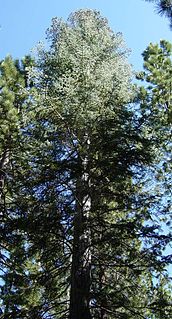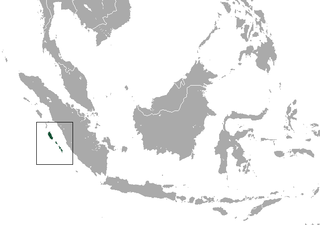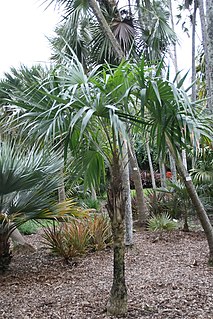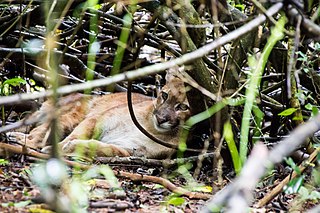
The cougar is a large cat of the subfamily Felinae. Native to the Americas, its range spans from the Canadian Yukon to the southern Andes in South America and is the most widespread of any large wild terrestrial mammal in the Western Hemisphere. It is an adaptable, generalist species, occurring in most American habitat types. Due to its wide range, it has many names, including puma, mountain lion, catamount, panther and painter.

Firs (Abies) are a genus of 48–56 species of evergreen coniferous trees in the family Pinaceae. They are found through much of North and Central America, Europe, Asia, and North Africa, occurring in mountains over most of the range. Firs are most closely related to the genus Cedrus (cedar). Douglas firs are not true firs, being of the genus Pseudotsuga.

Abies concolor, the white fir, is a coniferous tree in the pine family Pinaceae. This tree is native to the mountains of western North America from the southern Cascade range in Oregon, south throughout California and into the Sierra de San Pedro Mártir in northern Baja California; east through parts of southern Idaho, to Wyoming; and south throughout the Colorado Plateau and southern Rocky Mountains in Utah and Colorado, and into the isolated mountain ranges of southern Arizona, New Mexico and northern Mexico. White fir live over 300 years and naturally occur at an elevation between 900–3,400 m (2,950–11,200 ft).

The pig-tailed langur, monotypic in genus Simias, is a large Old World monkey, endemic to several small islands off the coast of Sumatra in Indonesia. Its face is black, its fur is blackish-brown and it has a relatively short tail. It is a diurnal species, feeding in small groups in the rainforest canopy on leaves, and to a lesser extent, fruit and berries. Little is known of its natural history, but it is heavily hunted, its populations have been declining rapidly and the International Union for Conservation of Nature has assessed its conservation status as being "critically endangered". It has been included on a list of the World's 25 Most Endangered Primates.

The southern white-breasted hedgehog, sometimes referred to as white-bellied hedgehog or white-chested hedgehog, is a hedgehog native to Eastern Europe and Southwestern Asia.

Nomascus is the second-most speciose genus of gibbons. Originally, this genus was a subgenus of Hylobates, and all individuals were considered one species, Hylobates concolor. Species within Nomascus are characterized by 52 chromosomes. Some species are all black, some are light with a distinct black tuft of crown fur, and some have distinct, light-colored cheek patches. Nomascus is found from southern China (Yunnan) to southern Vietnam, and also on Hainan Island. One species, Nomascus nasutus, has been deemed "the most critically endangered ape species in the world". All species in this genus are either endangered or critically endangered.

The brown fruit-eating bat is a bat species from South America. It is found in Brazil, Colombia, Ecuador, French Guiana, Guyana, Peru, Suriname and Venezuela.

Oecomys concolor, also known as the unicolored oecomys, unicolored rice rat, or unicolored arboreal rice rat, is a species of rodent in the genus Oecomys of family Cricetidae. It is found in tropical rainforest in the Amazon biome, but its range is poorly documented; it has been recorded in northwestern Brazil, southeastern Colombia, and southern Venezuela.

Schippia concolor, the mountain pimento or silver pimeto, is a medium-sized palm species that is native to Belize and Guatemala. Named for its discoverer, Australian botanist William A. Schipp, the species is threatened by habitat loss. It is the sole species in the genus Schippia.

The brown-tailed mongoose, brown-tailed vontsira, Malagasy brown-tailed mongoose, or salano is a species of mammal in the family Eupleridae. It is endemic to Madagascar. Its natural habitat is subtropical or tropical dry forests. It is threatened by habitat loss.

Anamera is a genus of longhorn beetles of the subfamily Lamiinae, containing the following species:

Anamera alboguttata is a species of beetle in the family Cerambycidae. It was described by James Thomson in 1864. It is known from Laos, Vietnam, India, Myanmar, and Thailand.
Anamera fulvescens is a species of beetle in the family Cerambycidae. It was described by Charles Joseph Gahan in 1893. It is known from India.
Anamera gigantea is a species of beetle in the family Cerambycidae. It was described by Stephan von Breuning in 1935. It is known from Pakistan and India.
Anamera obesa is a species of beetle in the family Cerambycidae. It was described by Maurice Pic in 1928. It is known from Myanmar, Laos and Vietnam.
Anamera similis is a species of beetle in the family Cerambycidae. It was described by Stephan von Breuning in 1938. It is known from Myanmar and Laos.
Anamera strandi is a species of beetle in the family Cerambycidae. It was described by Stephan von Breuning in 1935. It is known from Myanmar.
Anamera strandiella is a species of beetle in the family Cerambycidae. It was described by Stephan von Breuning in 1944. It is endemic to India.

The South American cougar, also known as the Andean mountain lion or puma, is a cougar subspecies occurring in northern and western South America, from Colombia and Venezuela to Peru, Brazil, Argentina and Chile.

Symphyotrichum concolor is a species of flowering plant in the family Asteraceae native to the Atlantic coastal plain and Piedmont areas of the eastern United States, as well as the Bahamas. Commonly known as eastern silvery aster, it is a perennial, herbaceous plant that may reach 30 to 80 centimeters in height. Leaves are a grayish-green and have a silky look and feel. The flowers have 8–12 rose-purple, rarely white, ray florets, and pink then purple disk florets.












